Translate this page into:
Average daily intake of artificially food color additives by school children in Saudi Arabia
⁎Corresponding author. masifa@ksu.edu.sa (Mohammed Asif Ahmed)
-
Received: ,
Accepted: ,
This article was originally published by Elsevier and was migrated to Scientific Scholar after the change of Publisher.
Peer review under responsibility of King Saud University.
Abstract
Food safety is related to nutritional risk in children. This study is to determine the types of artificial food color additives (AFCAs) daily intake by school children aged 6 to 17 years for ten AFCAs. Sunset Yellow (E110), Tartrazine (E102), Carmoisine (E122), Brilliant Blue (E133), Allura Red (E129), Black PN (E151), Indigo Carmine (E132), and Fast Green (E143) were identified using 24 h food consumption questionnaire, including the two unapproved AFCAs, Red 2G (E128) and Erythrosine (E127) in 839 food products. These food products are distributed into nine categories, containing juices and drinks, ice cream, cakes, jelly, chocolates, candy, chips, biscuits, and chewing gum. Results showed that the artificial food colors, Carmoisine (32.3 %) and Sunset Yellow (30.1 %) were the most highly consumed AFCAs by school children, whereas Erythrosine (0.05 %) was consumed the least. Therefore, Sunset Yellow was highly consumed (30.1 %) and detected in high amounts by high performance liquid chromatography, (HPLC) 34.2 %. The average daily intake (ADI) of AFCAs decreased with age to varying degrees in both sexes. In comparison to the Food and Agriculture Organization and World Health Organization, acceptable daily intakes, most permitted colors exceeded their acceptable daily intakes (ADIs) in the 6–11 years of age groups, and most permitted colors were within the recommended ADIs in the 12–17 years of age group. The average daily intake of AFCAs by school children decreased with age. Therefore, further studies are required to gain information about the possible negative health effects of high intake of these AFCAs on the test population.
Keywords
Artificial food color additives
Average daily intake
Carmoisine
Food products
School children
FD&C
1 Introduction
Food color is the substance added to various foods or drinks and has been a common practice for many centuries, serving many technical purposes. For example, to compensate the color loss caused by thermal/temporal processing state, the production process, packaging, storage, or distribution and to enhance naturally occurring colors, to ensure batch to consolidate batch, thereby preserving food identity, and to protect vitamins and flavors, which might be sunlight-sensitive while being stored (Ghorpade et al., 1995; Stich, 2016). Color has generally been added to make quality visually attractive, to promote flavor recognition, and to meet consumer prospects. Foods products like biscuits, cakes, pastries, ice cream, cured meats, soft drinks, cheese, margarine, confectionery, and candy, are still manufactured with color added. Before the 1950 s, manufacturers used natural pigments from plants and vegetables, minerals, microalgae, and pigment-producing microorganisms, such as beets (bright red), chlorophyll (green), to color the candy and food, which was a quick and easy process and extracts from other spices and plants (Dikshit and Tallapragada, 2018; Shamina et al., 2008). Due to improved cooperation in the food industry, the chemical industry experienced a boom after the World War II. This led to the inclusion of synthetic petroleum-based ingredients as AFCAs sources, which became increasingly popular among food manufacturers due to manufacturing advantages such as lower cost, longer shelf life, improved appearance, high color intensity, greater color stability, and uniformity (Dey and Nagababu, 2022).
The safety of a chemical compound is used to calculate the amount required to kill 50 % of the test animals. The risk to humans is then calculated using extrapolated data. Unfortunately, when the first synthetic color additive was used in foods, no toxicological studies were conducted. To assess the possible negative effects of a chemical substance on people's health, toxicological studies are essential (Drakvik et al., 2020).
In general, AFCAs have become more widely used in recent years due to concerns about their safety (FAO/WHO, 2007). A variety of disorders, diseases, and mutations in humans can be caused by most chemicals used in synthetic color sources.
There are now issues about the long-term effects of some AFCAs due to increased public awareness. Some food dyes are legal in one country but banned in another, for example, Red 2 (Amaranth) is legal in Japan, EU and China but illegal in the United States (US) and India. Similarly, the use of Red 40 (Allura Red) is prohibited in India but permitted in Japan, EU, China, and the US (Mishra, 2020).
Several researches have been conducted to investigate the carcinogenic effects of flavors and AFCAs. However, rare researches have examined how eating foods with AFCAs on children affects their behavior (Arnold et al., 2012; Trasande et al., 2018). Recently, Reading (2004) reported that 3-year-old boys exhibited undesirable behavior, as assessed by parental ratings, after consuming a mixture of four AFCAs and sodium benzoate. An earlier study found that a combination of AFCAs and the protective sodium benzoate in food groups risen hyperactivity in 3, 8, and 9 year-old children (Hashimoto, 2008).
Some AFCAs, like Tartrazine (E102), was already linked to asthma, allergies, and hyperactivity in kids (Kamal and Fawzia, 2018; Sharma and Choudhary, 2020). The UK Food Standards Agency and the European Food Safety Authority have ordered that all dietary groups comprising Sunset Yellow (E110), Carmoisine (E122), Tartrazine (E102), Quinoline Yellow (E104), Allura Red (E129), and Ponceau 4R (E124) be labeled “May impair activity and attention in children” as of July 20, 2010 (Scotter, 2011).
Several states and regions have their own rules regarding the kind, use, purity, and quantity of AFCAs allowed in the food manufacturing (Corradini, 2019; Silva et al., 2022). Nutritional modeling is a crucial step in the risk assessment procedure and a useful tool for identifying the presence of chemicals in the diet (Keener, 2022). Consumption data and concentrations are used to estimate the exposure to AFCAs, and compare the outcomes to established health benchmarks. For numerous years, food standards agencies around the world have used dietary models as portion of the risk assessment manner to identify unacceptable public health risks. The accuracy of dietary exposure estimates depends on the quality of the food levels and food intake data used in nutritive modeling (Keener, 2022; Kettler et al., 2015).
The United States Food and Drug Administration (FDA) has approved the use of nine AFCAs (USFDA, 2017). Many nations have strategy to make to limit the quantity, quality, purity, and use of permitted AFCAs to limit their misuse. The Food and Agriculture Organization (FAO) and the World Health Organization's (WHO) Joint Expert Committee on Food Additives (JECFA) strongly advise governments to regularly monitor the total intake of each food additive, especially when their use is being exploited and/or the total intake exceeds the permitted levels. National nutritional studies determine the allowable levels of each synthetic color additive. Regrettably, no studies have been carried out in Saudi Arabia on the total intake of AFCAs consumed by school going children. The purpose of this research was to assess the dietary intake of AFCAs by school going children.
2 Materials and methods
2.1 Twenty-four hours food consumption data
Before conducting the survey, a total of 839 food items that are frequently consumed by school children were bought from various hypermarkets in Riyadh, Saudi Arabia. These products were distributed into 9 kinds, biscuits, juices and drinks, cakes, chips, chocolates, ice cream, jelly, candy, and chewing gum.
School-age children aged 6–17 years old Saudi and non-Saudi enrolled in public, private, international primary and secondary schools were the target population, because they are considered to be the major consumers of synthetic food color additives among Saudi Arabia's various population groups.
The total enrolled student population of Riyadh region schools was obtained from the Saudi Ministry of Education's statistical department and divided into several strata. This includes nationality as well as other population characteristics such as gender, educational level, governorate, school sector, age group. Each sample was taken at random from each stratum, which was treated as a separate population.
The study team conducted individual interviews with children at their schools and instructed them to use photographs of food products to recognize the kinds and amounts of food groups they consumed during and between meals in the previous 24 h.
The questions were created to gather the information required to evaluate how much food school-going children 6 (6–17 years old) consume. The survey was distributed into five parts: student, parent, school, child weight and height, and food consumed in the previous 24 h.
The 24 h dietary recall field survey data were entered into a database using Microsoft Excel. The Statistical Analysis System (SAS) Version 9.1.3 was used to perform statistical analysis on the stored data (SAS, 2010). A descriptive statistics SAS program was used on the stored data to generate summaries of average daily food intake by age group for each parameter based on gender, nationality, education level, and school sector.
2.2 Food sample analysis
Dry foods (such as chips and biscuits), decomposable food and ice cream samples were stored at room temperature, 4 °C and −20 °C, respectively, until analyzed. Analysis of all food samples were carried out in triplicate. The AFCAs were extracted and analyzed by HPLC using method described by Ahmed et al. (2021).
2.3 Estimation of dietary intake (EDI) of AFCAs based on food consumption
Assessment of the dietary intakes of AFCAs were carried out using monitoring data and food consumption data. The monitoring data were obtained in this study by analyzing the AFCAs in samples. Food consumption data were given by the individual food intakes of school children in 24 h food consumption survey. The EDI of the AFCAs were calculated using the following equation:
Where Ci is the mean concentration or the positive mean concentration of AFCAs in i food (mean, mg kg−1); CDi is the consumption data of i food (g day−1); n is number of tested samples; and BW is average body weight (kg).
3 Results
3.1 Average daily intake of AFCAs in food groups commonly consumed by school children
The levels of AFCAs in food groups (Table 1) consumed by 6–17 years old Saudi Arabian school children were examined and the range of concentrations found is shown in Table 2. Eight approved AFCAs, containing Sunset Yellow (E110), Tartrazine (E102), Fast Green (E143), Carmoisine (E122), Allura Red (E129), Brilliant Blue (E-133), Indigo Carmine (E132), and Black PN (E151), and two unapproved additives, Red 2G (E128) and Erythrosine (E127), were examined in 839 food categories commonly consumed by Saudi school boys and Saudi school girls aged 6 to 17. E number: International numbering system.
FD&C Name
Common name
E- Number
Chemical structure
FD&C Yellow 5
Tartrazine
E-102

FD&C Yellow 6
Sunset Yellow
E-110

FD&C Red 5
Carmoisine
E-122

FD&C Red 3
Erythrosine
E-127

FD&C Red 11
Red 2G
E-128

FD&C Red 40
Allura Red
E-129

FD&C Blue 2
Indigo Carmine
E-132

FD&C Blue 1
Brilliant Blue
E-133
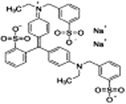
FD&C Green 3
Fast Green FCF
E-143

FD&C Black 1
Black PN
E-151
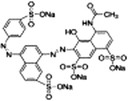
Food color
Food category
Range
Tartrazine
Juices and drinks
0–26.26
Ice cream
0–0.19
Candy
0–19.67
Jelly
0–5.8
Sunset Y
Chocolates
0–217.06
Juices and drinks
0–224.62
Ice cream
0–4.98
Candy
0–46.5
Jelly
0–14.31
Chewing gum
0–8.19
Carmoisine
Juices and drinks
0–114.03
Candy
0–12.27
Jelly
0–5.14
Chewing gum
0–15.89
Erythrosine
Candy
0–1.1
Jelly
0–0.2
Red 2G
Juices and drinks
0–109.36
Candy
0–49.7
Jelly
0–26.25
Allura Red
Ice cream
0–2.8
Candy
0–76.26
Jelly
0–42.8
Indigo Carmine
Candy
0–59.31
Brilliant Blue
Juices and drinks
0–5.12
Candy
0–193.21
Jelly
0–33.24
Chewing gum
0–0.57
Fast Green
Candy
0–5.58
Jelly
0–11.92
Black PN
Jelly
0–175.3
As shown in Table 3, both boys and girls consumed more AFCAs, including Carmoisine (33.4, 31.1 %) and Sunset Yellow (30.5, 29.6 %). Daily consumption of other AFCAs by boys and girls are less, including Tartrazine (4.97, 4.62 %), Brilliant Blue (2.62, 2.50 %), Indigo Carmine (2.61, 2.01 %), Allura Red (1.84, 2.38 %), Fast Green (0.35, 0.49 %), and Black PN (5.75, 10.58 %). From the two unapproved AFCAs, Red 2G (17.9, 16.7 %) was consumed more frequently than Erythrosine (0.05 % each) by 6–17 years old boys and girls school children in Saudi Arabia. * ADIs: Food and Agriculture Organization and World Health Organization acceptable daily intakes (ADIs) as set by the Joint-FAO/WHO-Expert-Committee (2002).
Age (Years)
ADI* (mg kg−1 BW)
6 to 7
8 to 9
10 to 11
12 to 13
14 to 15
16 to 17
Distribution (%)
AFCAs
Male
Female
Male
Female
Male
Female
Male
Female
Male
Female
Male
Female
Male
Female
Tartrazine
75
154
127
109
99.9
87.2
89.3
82.8
70.9
62.2
58.4
79.3
59.2
4.97
4.62
Sunset Yellow
450
944
825
702
614
569
548
512
448
382
395
415
397
30.5
29.6
Carmoisine
460
1101
855
688
676
567
586
558
466
423
396
520
410
33.4
31.1
Erythrosine
0.93
0
1.23
2.31
0.93
1.44
1.34
0.81
1.04
0.58
0.53
1.2
0.3
0.05
0.05
Red 2G
258
567
456
381
362
311
321
298
255
226
214
282
214
17.9
16.7
Allura Red
44
0
60.9
56.8
48.9
60.5
56.7
36.3
45.1
26.6
36.7
31.6
11.5
1.84
2.38
Indigo Carmine
44
0
53.3
118.8
36.5
62.2
55.3
36.3
43.2
22.6
14.3
61.9
16.8
2.61
2.01
Brilliant Blue
45
50.1
65.1
75
51.6
56.6
55.8
42.3
43.7
32.3
31.9
46.3
24.3
2.62
2.5
Fast Green FCF
9.1
0
10.64
10.2
9.9
12.52
12.78
6.32
9.75
6.29
9.1
5.13
1
0.35
0.49
Black PN
205
0
216
99.3
222
255
274
121
207
142
235
46.5
0
5.75
10.58
(% Male)
24.4
19.4
17.2
14.7
11.5
12.9
(% Female)
24.5
19.5
18.3
14.6
12.7
10.4
According to the frequency of consumption questionnaire, Erythrosine and Fast Green were consumed frequently. Male school children of all ages consumed the following food products containing AFCAs daily, Tartrazine 62–154 mg (5 %), Sunset Yellow 382–944 mg (31 %), Carmoisine 423–1101 mg (33 %), Red 2G (226–567 mg (18 %), Allura Red 0–61 mg (2 %), Indigo Carmine 0–119 mg, (3 %), Brilliant Blue 32–75 mg (3 %), and Black PN 0–255 mg (6 %). However, among school going female children who consume foods and drinks with AFCAs on the daily basis, are Tartrazine 58–127 mg (5 %), Sunset Yellow 395–825 mg (30 %), Carmoisine 396–855 mg (31 %), Red 2G 214–456 mg (17 %), Allura Red 12–61 mg (2 %), Indigo Carmine 14–55 mg (2 %), Brilliant Blue 24–65 mg (3 %), and Black PN 0–274 mg (11 %).
As shown in Fig. 1, the average daily intakes (ADI) of artificial food colors decreased to varying degrees with increasing age in both genders.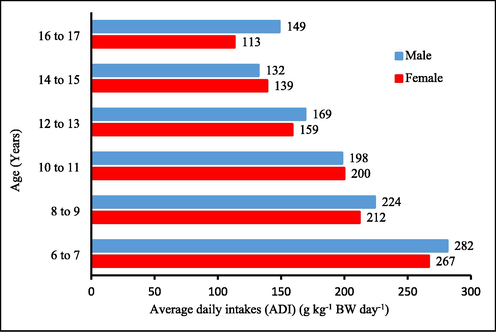
Average daily intake (ADI) of artificial food colors (g kg-1 BW day-1) by male and female school children aged 6–17 years in Saudi Arabia.
As shown in Fig. 2, the AFCAs were daily consumed among the total population of study at concentrations ranging from 0.05 % for Erythrosine up to 32.3 % for Carmoisine.
Distribution of average daily intake (ADI) of AFCAs (%) in the total population of study.
The artificial food colors in different analyzed food categories by HPLC were detected at different percentages (Fig. 3). Sunset Yellow (E110, 34.2 %), Brilliant Blue (E133, 15.4 %), Red 2G (E128, 12.3 %), Black PN (E151, 11.6 %), Carmoisine (E122, 9.8 %), Allura Red (E129, 8.1 %), Indigo Carmine (E132, 3.9 %), Tartrazine (E102, 3.4 %), Fast Green FCF (E143, 1.2 %), and Erythrosine (E127, 0.1 %). It was found that the most commonly used AFCAs was Sunset Yellow (E110) (34.2 %), which was detected at higher levels in Chocolates (0–217 mg/kg), juices and drinks (0–225 mg/kg). Brilliant Blue (0.0–193.21 mg/kg) and Carmoisine (0–114.03 mg/kg) were detected in juices and drinks, jelly, chewing gum, and candy. Black PN was identified in jelly in the range of 0–175.3 mg/kg, Fast Green FCF was found in jelly and candy in the range of 0–11.92 mg/kg, while Indigo Carmine was found in candy with the range 0–59.31 mg/kg. Allura Red was identified in jelly, candy, and ice cream in the range of 0–76.26 mg/kg. Tartrazine was found in candy, juices and drinks, jelly, and ice cream in the range of 0–26.26 mg/kg. In juices and drinks, candy, and jelly Red 2G was in the range of 0.0–109.36 mg/kg and 0.2–1.1 mg/kg for Erythrosine.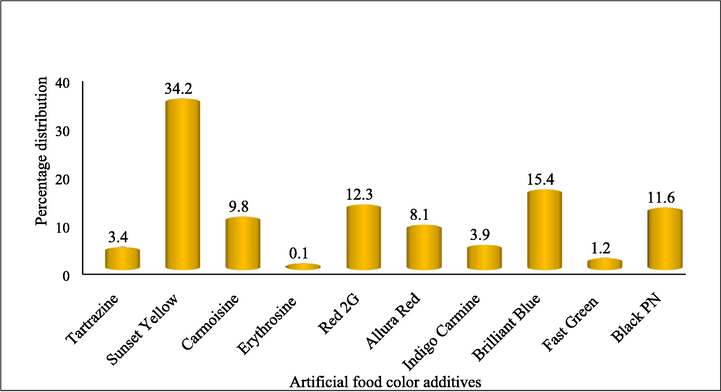
Artificial food color additives percentage observed by HPLC in the different food studied.
3.2 Consumption pattern of food products
The percentage distribution of food consumption during the 24 h food consumption survey questionnaire are depicted in Fig. 4. Among the nine food products, ice cream (44 %) as well as juices and drinks (30 %) were highly consumed by students. According to the 24 h dietary survey, chewing gum was consumed by 0.5 % of the population (0.3 % in boys and 0.2 % in girls).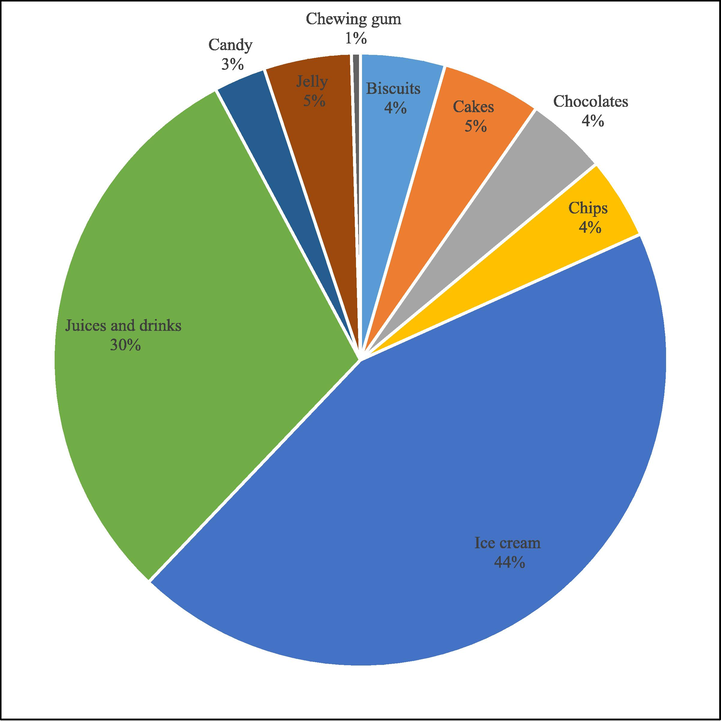
Average daily intake (ADI) of food products (% distribution).
Daily consumption of ice cream was higher in boys (1064.17 mL, 58.1 %) than in girls (768.92 mL, 41.9 %). Saudi boys were the highest consumer of ice cream (35.32 %) compared to Saudi girls (22.74 %), Non-Saudi boys (22.73 %), and Non-Saudi girls (19.20 %) (Table 4). Daily consumption of juices and drinks was higher in boys (52.6 %) than in girls (47.4 %). Saudi boys were the highest consumer of juices and drinks (28.15 %) compared to Saudi girls (24.36 %), Non-Saudi boys (24.84 %), and Non-Saudi girls (23.01 %) (Table 4).
Food Group
ADI (g)
ADI (%)
Saudi
Non-Saudi
Whole population
Saudi
Non-Saudi
Whole population
Boys
Girls
Boys
Girls
Boys
Girls
Boys
Girls
Boys
Girls
Boys
Girls
Biscuits
49.48
39.98
54.56
42.29
104.04
82.27
26.56
21.46
29.28
22.70
55.8
44.2
Cakes
58.35
55.23
53.47
51.95
111.82
107.18
26.64
25.22
24.42
23.72
51.1
48.9
Chocolates
43.95
43.24
49.83
41.19
93.78
84.43
24.66
24.26
27.96
23.11
52.6
47.4
Chips
39
54.1
36.75
50.63
75.75
104.73
21.61
29.98
20.36
28.05
42.0
58.0
Ice cream
647.5
416.92
416.67
352
1064.17
768.92
35.32
22.74
22.73
19.20
58.1
41.9
Juices & Drinks
353.89
306.31
307.74
289.35
661.63
595.66
28.15
24.36
24.48
23.01
52.6
47.4
Candy
35.9
28.41
25.78
24.14
61.68
52.55
31.43
24.87
22.57
21.13
54.0
46.0
Jelly
44.47
56.07
43.94
48.27
88.41
104.34
23.07
29.09
22.80
25.04
45.9
54.1
Chewing gum
5.94
4.47
4.94
4.37
10.88
8.84
30.12
22.67
25.05
22.16
55.2
44.8
%Whole population
30.58
24.03
23.77
21.63
54.3
54.3
Daily consumption of AFCAs for male students in Saudi and Non-Saudi nationality are biscuits 50–55 g, cakes 53–58 g, chocolates 44–50 g, chips 39–54 g, ice cream 417–648 mL, juices and drinks 308–354 mL, candy 26–36 g, jelly 44–45 g, and chewing gum 5–6 g. Girls school going children, consumed AFCAs in the following amounts on a daily basis, biscuits 40–42 g, cakes 52–55 g, chocolates 41–43 g, chips 51–54 g, ice cream 352–417 mL, juices and drinks 289–306 mL, candy 24–28 mL, jelly 48–56 g, and chewing gum 4.4–5.5 g.
Daily consumption of juices and drinks was the highest 234.8, 234.3, and 230.4 g in International, Private, and Governmental schools, respectively, compared to other food product. In addition, daily consumption of ice cream was 211.5, 196.1, and 145 g in Private, Governmental, and International schools, respectively (Fig. 5).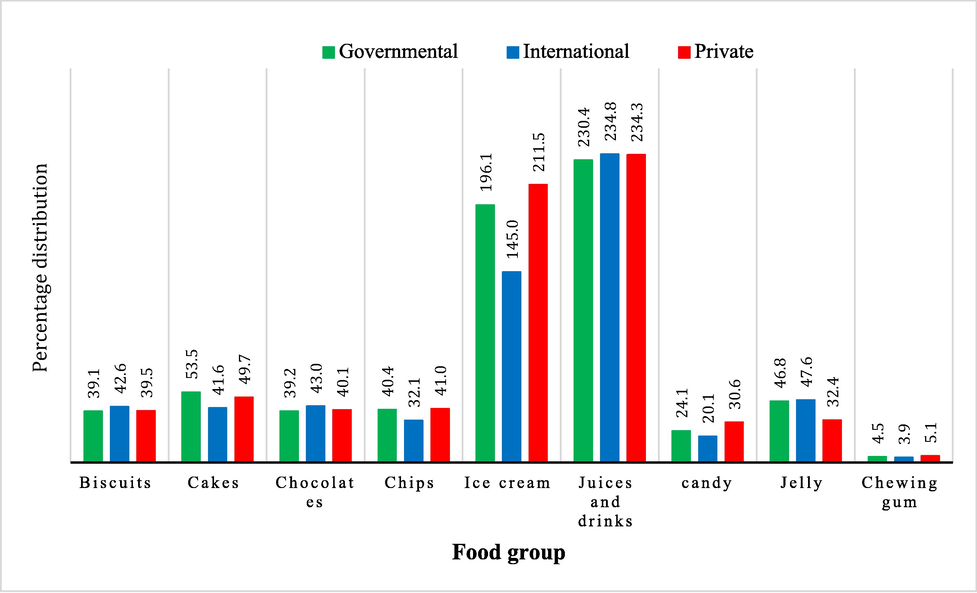
Daily food Intake (g) of food products in the schools (Governmental, International, and Private).
4 Discussion
In this study, AFCAs were found in various percentages in various food groups, mainly ice cream (44 %) and Juices and drinkers (30 %). Carmoisine (E122) (32.3 %) and Sunset Yellow (E110) (30.1 %) are the most common, in these food products. Interestingly, the other AFCAs, especially Erythrosine (0.05 %), were rarely used in food products. Kist-van Holthe et al. (2015) observed that Brilliant Blue (E133) (Number of times encountered, 41 times) was the most commonly consumed artificial color additive in foods, while Sunset Yellow (E110) (Number of times encountered, 8 times) and Carmoisine (E122) were the least commonly used artificial food color among children in Amsterdam. The much higher intakes of the dyes Carmoisine and Sunset Yellow among school-going children in Saudi Arabia could be due to high consumption of juices and drinks, followed by chocolates, and the high levels of these AFCAs in these food products. In agreement with Husain et al. (2006) age had a significant effect on the ADI of AFCAs, especially among children 6–7 years old, they showed significantly higher ADI of AFCAs than the other age groups This indicated that the content of AFCAs increased in young children and decreased to different degrees in both sexes. Since the ADI is calculated based on body weight, and children at these age groups have lower body weights than children in the other age groups, one might postulate that the intake of AFCAs tends to be more visible in children 5–8 years old than in older children, in addition to the fact that AFCAs such as Carmoisine and Sunset Yellow are more highly favored by younger children than the older ones. Nationality influenced ADI of AFCAs, Saudi children consumed more AFCAs than non-Saudi children, particularly those found in ice cream and juices and drinks. Furthermore, the type of school had a similar effect on ADI of AFCAs, with the exception of that found in ice cream, which decreased in children attending an international school. Gender had effect on ADI of AFCAs, with boys consuming more than girls in all studied AFCAs except Fast Green, Allura Red, and Black PN, where girls consumed more than boys.
In a comparison to acceptable daily intakes (ADIs) values of Food and Agriculture Organization and World Health Organization, the ADI of AFCAs exceeded in the 6–11 years age group, with the exception of Indigo Carmine in the female age 8–9 years and Black PN in the male age 8–9 years. Furthermore, Erythrosine, Allura Red, Indigo Carmine, Fast Green FCF, and Black PN were not consumed by males aged 6–7 years. On the other hand, the ADI of AFCAs for 12–17 years old groups, within the recommended ADIs, with the exception of Sunset Yellow, Carmoisine, and Black PN for 12–13 years in girls and Black PN for 14–15 years in girls, as well as Tartrazine, Carmoisine, Red 2G, Indigo Carmine, and Brilliant Blue for 16–17 years boys. This indicated that most AFCAs exceeded their acceptable daily intakes (ADIs) in the 6–11 years old age groups, but were within the recommended ADIs in the 12–17 years old age group. Younger school-age children (6–11 years age groups) consumed higher levels of AFCAs that exceeded their ADIs, whereas older school-age children (12–17 years age groups) consumed suitable levels of AFCAs that were within the recommended ADIs. This could be attributed to higher purchasing power, consumption of AFCAs, and lack of awareness in younger age groups.
In a study of 100 families in Abu Dhabi, the consumption of sunset Yellow by children under the age of seven exceeded their ADI of 2.5 mg/kg body weight (Marei and Hassan, 1995). Husain et al. (2006) reported that four approved AFCAs (Sunset Yellow, Tartrazine, Allura Red, and Carmoisine) were found to be significantly exceeded the acceptable daily intakes (ADIs) values of Food and Agriculture Organization and World Health Organization by the factors of 2–8 times, especially in young children. In contrary that the consumption of artificial food colorings was considerably lower than the ADI (Additives and Food, 2010; Kist-van Holthe et al., 2015). This indicates that these AFCAs may have adverse health effects. The most common food bio-colorants are flavonoids, carotenoids, anthocyanidins, betalain, chlorophyll, and crocin (Kaya et al., 2021). Although there are numerous benefits to adding AFCAs to foods, there is growing concern about the human health safety consequences of including AFCAs in human diets. Long-term exposure to AFCAs, in particular, can result in allergies, nausea, attention deficit hyperactivity disorder, and heart disease (Kaya et al., 2021). The safety of these AFCAs, has resulted in numerous studies, conducted by individual researchers, corporate organizations, and even government agencies, to validate the benefits or risks associated with the use of AFCAs. Therefore, toxicological studies have linked AFCAs to the development of allergy and hyperactivity symptoms in children. Furthermore, the risk of cumulative AFCAs consumption from various types of food products consumed throughout the day is questioned. Using the AFCAs found in food products as an example, the risk of toxicity from Sunset Yellow colors appears to be high when a child consumes one or more Chocolates, juices, and drinks during the day. When other AFCAs are consumed and ingested on a daily basis, the risk of toxicity increases.
Tartrazine (E102), a synthetic lemon-yellow azo dye; C16H9N4Na3O9S2, has the highest rate of intolerance and allergic reactions of any azo dye, as well as childhood hyperactivity, migraine headaches, skin rashes, and may contain carcinogen residues (Tuormaa 1994, Inetianbor et al., 2015). Sunset Yellow (E110) can cause health issues, particularly allergic reactions, in people who are sensitive to acetylsalicylic acid. It is also suspected of having hyperkinesia and potentially carcinogenic substance residues (Additives and Food 2014, Silva et al., 2022). Carmoisine (E122) Azorubine C20H12N2Na2O7S2, has no histopathological evidence of carcinogenic, mutagenic, or teratogenic properties but it appears to cause skin and respiratory allergic reactions in rare cases (Malczyk et al., 2015, Silva et al., 2022). The use of Erythrosine (C20H6I4Na2O5·H2O), which contains high levels of bound iodine, has been linked to allergic reactions and cancer (Inetianbor et al., 2015, Silva et al., 2022). Studies on humans revealed that only a small amount of erythrosine is absorbed and that it is almost completely excreted via feces (Joint and Organization 2017). Although several in vitro studies revealed positive genotoxicity findings, there are negative in vivo genotoxicity investigations (Joint and Organization 2017). Brilliant black PN (E151), C28H17N5Na4O14S4, has been linked to human health risks similar to those linked to other azo food colors. Although free sulfonated aromatic amines may enter the systemic circulation after azo reduction in the gastrointestinal tract, concerns about genotoxicity remain (Additives and Food 2010, Silva et al., 2022). Indigo Carmine (E132) (C16H8Na2O8S2), has no adverse effects in subacute, chronic, reproduction, or developmental toxicity studies, nor have changes in hematological and biological parameters been identified in chronic toxicity studies at lower doses (Joint and Organization 2017). Furthermore, human health effects related to allergy issues, as well as the possible presence of residues of potentially carcinogenic substances, have been reported (Silva et al., 2022). Brilliant Blue (E133) only about 5 % of E133 is absorbed from the gastrointestinal tract, with the remainder excreted. It can, however, be absorbed directly into the bloodstream via the tongue or shaved skin (Joint and Organization 2017). In terms of human health effects, Silva et al., (2022) reported that high doses can cause deposits in the kidneys and lymphatic vessels, as well as residues of potentially carcinogenic substances. In terms of potential side effects, Allura Red may produce allergens that cause asthma, rhinitis (including hay fever), or “urticarial” hives (Inetianbor et al., 2015). Allura Red is suspected of causing hyperkinesia and may contain carcinogenic residues (Silva et al., 2022).
The permissions for their use are regulated by the United States FDA and the European Food Safety Authority (EFSA) in order to provide safe food products to consumers (Martins et al., 2016). Specific critical values illustrate the safe levels of additive exposure. The highest concentration with no adverse effects under certain exposure conditions is referred to as the No observed adverse effect level (NOAEL). The acceptable daily intakes are a criterion that expresses the amount of substance that can be consumed daily per kilogram of body weight without causing harm. A numbering system known as “E numbers” has been established to aid in the identification, control and reduction of risk. The AFCAs classified under the E code and used based on their permitted amounts (Kaya et al., 2021). An AFCAs in food products are strictly regulated in Europe in accordance with Directive 94/35/EU (EC, 2001; Minioti et al., 2007). The Saudi Food and Drug Authority is presently updating the GCC Food Color Guidelines 285/1999 that govern the use of AFCAs in Saudi Arabia (SFDA). For Erythrosine, Brilliant black PN, Carmoisine, Indigo Carmine, Brilliant Blue, Allura Red, Sunset Yellow FCF, and Tartrazine, committees established acceptable daily intakes as 0.1, 1, 4, 5, 6, 7, 4, and 7.5 mg/kg body weight /day (Additives and Food 2009, Additives and Food 2010, Lucová et al., 2013, Additives and Food 2014, Malczyk et al., 2015, Joint and Organization 2017, Silva et al., 2022). Therefore, AFCAs-containing foods should be labeled with a warning that the food “may have an adverse effect on activity and attention in children”.
5 Conclusions
In conclusion, in the different food categories studied, Carmoisine (32.3 %) and Sunset Yellow (30.1 %) were the most generally consumed AFCAs by Saudi primary and secondary school children. Sunset Yellow was detected in high concentrations (34.2 %) by HPLC in food products. Ice cream (44 %) and juices and drinks (30 %) were the most popular foods among Saudi 6–17 years old boys and girls, while chewing gum (0.5 %) was the least popular. Average daily intake of AFCAs decreased with the age at different rates for both sexes. However, ten AFCAs exceeded their acceptable daily intakes (ADIs) in 6–11 years of age groups and within the recommended ADIs in 12–17 years of age group. However, Indigo Carmine in the female age 8–9 years, Black PN in the male age 8–9 years, and Erythrosine, Allura Red, Fast Green FCF, Indigo Carmine, and Black PN in the male aged 6–7 years were within the recommended ADIs. In addition, Tartrazine, Sunset Yellow, Carmoisine, and Red 2G for 12–13 years in male, Carmoisine, Erythrosine, and Black PN for 12–13 years in girls, Black PN for 14–15 years in girls, and Tartrazine, Carmoisine, Red 2G, Indigo Carmine, and Brilliant Blue for 16–17 years in boys were exceeded their ADIs. Data on the content of AFCAs would be useful to understand the eating habits of school going children and to choose suitable products to prevent the intake of excessive amounts of AFCAs that can harm children's health. Therefore, it is critical to conduct follow-up research to evaluate the potential health effects of high artificial color additives consumption in foods at younger ages.
Acknowledgement
This project was funded by the National Plan for Science, Technology and Innovation (MAARIFAH), King Abdulaziz City for Science and Technology, Kingdom of Saudi Arabia, Award number (08-MED-569-02).
Declaration of Competing Interest
The authors declare that they have no known competing financial interests or personal relationships that could have appeared to influence the work reported in this paper.
References
- Additives, E.P.o.F., Food, N.S.A.t., 2009. Scientific opinion on the re‐evaluation tartrazine (e 102). EFSA Journal. 7 (11), p.1331
- Additives, E.P.O.F., Food, N.S.A.T., 2010. Scientific opinion on the re‐evaluation of brilliant blue FCF (e 133) as a food additive. EFSA Journal. 8 (11):1853
- Additives, E.P.o.F., Food, N.S.a.t., 2010. Scientific opinion on the re‐evaluation of green s (e 142) as a food additive. EFSA Journal. 8 (11):1851
- Additives, E.P.o.F., Food, N.S.A.t., 2014. Reconsideration of the temporary adi and refined exposure assessment for sunset yellow FCF (e 110). EFSA Journal. 12 (7), 3765
- Dietary intake of artificial food color additives containing food products by school-going children. Saudi J. Biol. Sci.. 2021;28(1):27-34.
- [Google Scholar]
- Artificial food colors and attention-deficit/hyperactivity symptoms: conclusions to dye for. Neurotherapeutics 2012
- [Google Scholar]
- Applications of food colour and bio-preservatives in the food and its effect on the human health. Food Chem. Adv. 2022100019
- [Google Scholar]
- Comparative study of natural and artificial flavoring agents and dyes. Natural and artificial flavoring agents and food dyes: Elsevier, Academic Press; 2018. p. :83-111.
- Statement on advancing the assessment of chemical mixtures and their risks for human health and the environment. Environ. Int.. 2020;134:105267
- [Google Scholar]
- EC, 2001. Report from the commission on dietary food additive intake in the European Union, Commission of the European Communities Brussels (Belgium). 542
- FAO/WHO, 2007. Evaluation of certain food additives and contaminants: Sixty-seventh report of the joint fao/who expert committee on food additives. Meeting world health organization, World Health Organization. (Vol. 67)
- Food colors. Vol Vol. 4. New York: Marcel Dekker Inc.; 1995.
- Food additives and hyperactive behavior in children. Clin. Psychopharmacol. Neurosci.. 2008;6(2):79.
- [Google Scholar]
- Estimates of dietary exposure of children to artificial food colours in kuwait. Food Addit. Contam.. 2006;23(3):245-251.
- [Google Scholar]
- Effects of food additives and preservatives on man-a review. Asian J. Sci. Technol.y.. 2015;6(2):1118-1135.
- [Google Scholar]
- Compendium of food additive specifications. Joint fao/who expert committee on food additives, 84th meeting 2017. FAO JECFA Monographs. 2017;20:1-108.
- [Google Scholar]
- Joint-FAO/WHO-Expert-Committee, 2002. Summary of evaluations performed by the joint fao/who expert committee on food additives. http://www. inchem. org/documents/jecfa/jeceval/jec_1174. htm.
- Toxicological and safety assessment of tartrazine as a synthetic food additive on health biomarkers: a review. Afr. J. Biotechnol.. 2018;17(6):139-149.
- [Google Scholar]
- Latest advances on the nanomaterials-based electrochemical analysis of azo toxic dyes sunset yellow and tartrazine in food samples. Food Chem. Toxicol.. 2021;156:112524
- [Google Scholar]
- Food safety and regulatory survey of food additives and other substances in human food. Ensuring global food safety: Elsevier; 2022. p. :259-273.
- Assessing and reporting uncertainties in dietary exposure analysis: Mapping of uncertainties in a tiered approach. Food Chem. Toxicol.. 2015;82:79-95.
- [Google Scholar]
- Consumption of artificial food colourings by school children in the netherlands. Adv. Pediatr. Res.. 2015;2(5)
- [Google Scholar]
- Absorption of triphenylmethane dyes brilliant blue and patent blue through intact skin, shaven skin and lingual mucosa from daily life products. Food Chem. Toxicol.. 2013;52:19-27.
- [Google Scholar]
- An assessment of the intake of synthetic food colors by 10–15-year-old children. Pielęgniarstwo i Zdrowie Publiczne Nursing Public Health. 2015;5(4):323-331.
- [Google Scholar]
- Possible hazards from food colours with specific study for some foods (pofak and cheese balls) in uae market. Abu Dhabi, United Arab Emirates: Food and Environment Control Center; 1995.
- Food colorants: Challenges, opportunities and current desires of agro-industries to ensure consumer expectations and regulatory practices. Trends Food Sci. Technol.. 2016;52:1-15.
- [Google Scholar]
- Determination of 13 synthetic food colorants in water-soluble foods by reversed-phase high-performance liquid chromatography coupled with diode-array detector. Anal. Chim. Acta. 2007;583(1):103-110.
- [Google Scholar]
- Food colors and associated oxidative stress in chemical carcinogenesis. Handbk. Oxid. Stress Cancer: Mech. Asp.. 2020;2020:1-4.
- [Google Scholar]
- The effects of a double blind, placebo controlled, artificial food colourings and benzoate preservative challenge on hyperactivity in a general population sample of preschool children. Wiley Online Library. 2004;89(6):506-511.
- [Google Scholar]
- SAS, 2010. SAS institute. User’s guide: Statistics, version 9.3, SAS Inst. Inc. Cary, North Caroline, USA
- Emerging and persistent issues with artificial food colours: natural colour additives as alternatives to synthetic colours in food and drink. Qual. Assur. Saf. Crops Foods. 2011;3(1):28-39.
- [Google Scholar]
- Tartrazine synthesis, applications and issues: a case study. J. Crit. Rev.. 2020;7:2437-2441.
- [Google Scholar]
- Food colour additives: a synoptical overview on their chemical properties, applications in food products, and health side effects. Foods. 2022;11(3):379.
- [Google Scholar]
- Stich, E., 2016. Food color and coloring food: Quality, differentiation and regulatory requirements in the european union and the united states. Handbook on natural pigments in food and beverages, Elsevier: 3-27
- Tuormaa, T.E., 1994. The adverse effects of food additives on health: A review of the literature with a special emphasis on childhood hyperactivity. Journal of Orthomolecular Medicine. 9: 225-225.
- USFDA, 2017. Us food and drug administration, 2017. Summary of color additives for use in the united states in foods, drugs, cosmetics, and medical devices. Https://www.Fda.Gov/industry/color-additive-inventories/summary-color-additives-use-united-states-foods-drugs-cosmetics-and-medical-devices#ftnote2 (accessed 17 may 2020).







